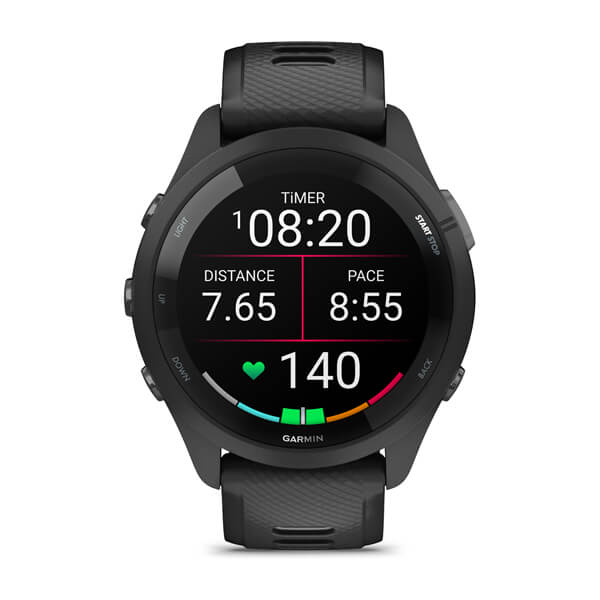⚡ Key Specifications
✅ Best For
- Serious runners
- Marathon training
- Data-driven athletes
- Long battery life needs
- iOS and Android users
⚠️ Not Recommended For
- Casual fitness users
- Smart features priority
- Navigation needs (get 965)
- Very small wrists
📷 Product Images (3 total)



✓ Pros
- Beautiful AMOLED display
- Excellent battery life despite AMOLED
- Training readiness and HRV status
- Multi-band GPS accuracy
- Morning report feature
- Music storage included
- Comprehensive running metrics
✗ Cons
- No maps navigation
- Limited smart features
- Plastic build feels less premium
- Touch screen can be finicky
- No voice assistant
📱 Display
AMOLED • 1.3" • x
1000 nits brightness
Always-On🔋 Battery Life
13 days typical use
20 hours GPS
15 days power save
❤️ Health Tracking
Heart Rate SpO2 Sleep Stress🛒 Where to Buy - All Retailers
Garmin Forerunner 265
Overview
The Garmin Forerunner 265 represents a perfect balance in Garmin’s running watch lineup, bringing a gorgeous AMOLED display to the mid-tier while maintaining the exceptional battery life Garmin is known for. With training readiness, HRV status, and multi-band GPS, it offers pro-level features without the pro-level price of the 965.
Key Features That Matter
- AMOLED Display: Finally, a bright, vibrant screen in the mid-range
- Training Readiness: Know when to push hard or recover
- HRV Status: Track heart rate variability trends
- Multi-band GPS: L1+L5 dual frequency for superior accuracy
- Morning Report: Daily briefing on sleep, recovery, and weather
- 13-day battery: Impressive considering the AMOLED display
The AMOLED Difference
Coming from the MIP display of the 255, the AMOLED is transformative:
- Brightness: 1000 nits makes it readable in direct sunlight
- Colors: Maps, charts, and data pop with vibrancy
- Always-on: Still manages 13 days with AOD enabled
- Touch screen: Swipe through widgets and menus (buttons still primary)
However, some runners prefer MIP for better visibility in certain lighting conditions and zero battery impact.
Training Features Excellence
The 265 includes Garmin’s latest training science:
Training Readiness
Combines multiple metrics to score your readiness (0-100):
- Sleep quality and duration
- Recovery time remaining
- HRV status
- Acute training load
- Stress levels
HRV Status
New overnight HRV measurement provides:
- 7-day average baseline
- Trending indicators
- Balance with training load
- More accurate than spot checks
Race Predictor & PacePro
- Predicts 5K, 10K, half, and full marathon times
- PacePro provides GPS-based pace guidance
- Accounts for elevation changes
- Course-specific strategies
Real-World Performance
GPS Accuracy
Multi-band GPS delivers:
- Open areas: Within 1-2 meters consistently
- Urban canyons: Significantly better than single-band
- Tree cover: Excellent track following
- Track running: Near-perfect 400m laps
The dual-frequency GPS is worth the battery trade-off for serious runners.
Battery Life Reality
Garmin claims 13 days, real-world:
- Everything on: 10-11 days (AOD, SpO2, notifications)
- Typical use: 12-13 days (AOD, no SpO2)
- GPS activities: 20 hours continuous
- GPS + Music: 7 hours
- UltraTrac mode: 42 hours
This crushes Apple Watch and most competitors despite AMOLED.
Heart Rate Accuracy
The Elevate 4 sensor performs well:
- Easy runs: Within 1-2 bpm of chest strap
- Intervals: 3-5 second lag on changes
- Daily wear: Excellent resting HR
- Cold weather: Can struggle with vasoconstriction
For critical training, pair with a chest strap via ANT+.
265 vs 265S Decision
Two sizes available:
- 265 (46mm): Standard size, 47g, better battery
- 265S (42mm): Smaller option, 39g, slightly less battery
The S model loses about 10-15% battery life but is much better for smaller wrists. Both have the same features otherwise.
Music Storage
4GB storage provides:
- ~500 songs offline
- Spotify, Amazon Music, Deezer support
- Bluetooth headphone connection
- Sync over WiFi
- Controls for phone music too
Music significantly impacts battery (7 hours GPS+Music vs 20 hours GPS only).
Who Should Buy the 265?
Perfect For:
- Runners training for specific goals
- Data enthusiasts who love metrics
- Those wanting AMOLED without 965 price
- Athletes needing accurate GPS
- Users wanting week+ battery life
Should Consider 965 Instead If:
- You need full navigation maps
- Budget allows the extra $150
- You want barometric altimeter
- Triathlon features are important
Should Consider 255 Instead If:
- You prefer MIP displays
- Budget is tight ($100 less)
- You don’t need AMOLED or Training Readiness
Missing Features
Notable omissions vs 965:
- No preloaded maps
- No barometric altimeter
- Smaller screen (1.3 inch vs 1.4 inch)
- Less premium materials
- No real-time stamina
These are acceptable trade-offs for most runners saving $150.
Purchase Timing
The 265 launched March 2023:
- Current generation, no update imminent
- Black Friday sees $50-75 discounts
- Refurbished units save $75-100
- 255 still available and capable for less
Verdict
The Forerunner 265 hits the sweet spot for serious runners who want modern features without breaking the bank. The AMOLED display modernizes the experience while training readiness and HRV status provide pro-level insights. Multi-band GPS ensures accurate data, and the 13-day battery life means you’ll rarely think about charging.
At $449, it’s not cheap, but it offers 90% of the 965’s capabilities for $150 less. Unless you specifically need maps or do triathlons, the 265 provides everything a dedicated runner needs. It’s quite simply the best value in a premium running watch today.
Bottom line: Buy the 265 if you’re a serious runner who wants the latest training metrics and beautiful AMOLED display without the flagship price. It’s the running watch Garmin fans have been waiting for.